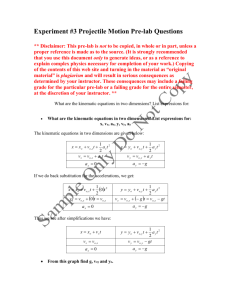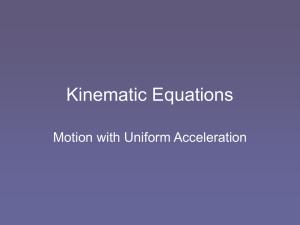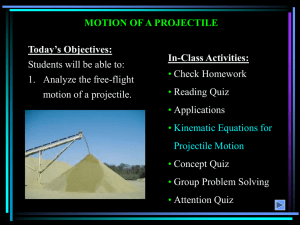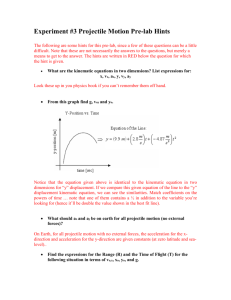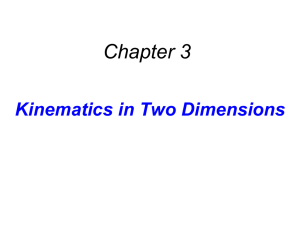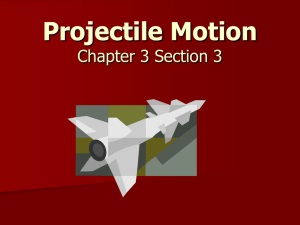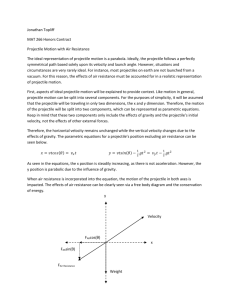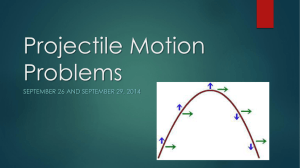Motion of projectiles
advertisement
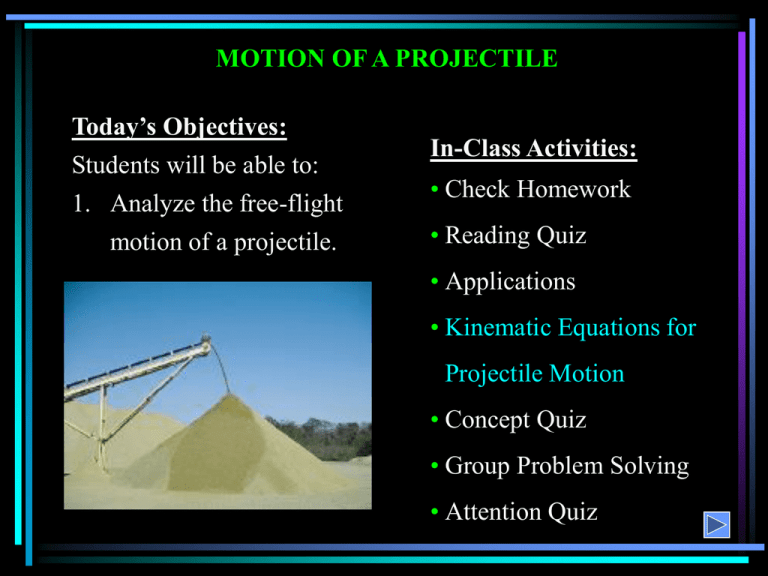
MOTION OF A PROJECTILE
Today’s Objectives:
Students will be able to:
In-Class Activities:
1. Analyze the free-flight
motion of a projectile.
• Reading Quiz
• Check Homework
• Applications
• Kinematic Equations for
Projectile Motion
• Concept Quiz
• Group Problem Solving
• Attention Quiz
APPLICATIONS
A good kicker instinctively knows at what angle, q, and initial
velocity, vA, he must kick the ball to make a field goal.
For a given kick “strength”, at what angle should the ball be
kicked to get the maximum distance?
APPLICATIONS
(continued)
A basketball is shot at a certain angle. What parameters should
the shooter consider in order for the basketball to pass through
the basket?
Distance, speed, the basket location, … anything else ?
MOTION OF A PROJECTILE
(Section 12.6)
Projectile motion can be treated as two rectilinear motions, one in
the horizontal direction experiencing zero acceleration and the other
in the vertical direction experiencing constant acceleration (i.e.,
from gravity).
For illustration, consider the two balls on the
left. The red ball falls from rest, whereas the
yellow ball is given a horizontal velocity. Each
picture in this sequence is taken after the same
time interval. Notice both balls are subjected to
the same downward acceleration since they
remain at the same elevation at any instant.
Also, note that the horizontal distance between
successive photos of the yellow ball is constant
since the velocity in the horizontal direction is
constant.
KINEMATIC EQUATIONS: HORIZONTAL MOTION
Since ax = 0, the velocity in the horizontal direction remains
constant (vx = vox) and the position in the x direction can be
determined by:
x = xo + (vox) t
Why is ax equal to zero (assuming movement through the air)?
KINEMATIC EQUATIONS: VERTICAL MOTION
Since the positive y-axis is directed upward, ay = – g.
Application of the constant acceleration equations yields:
vy = voy – g t
y = yo + (voy) t – ½ g t2
vy2 = voy2 – 2 g (y – yo)
For any given problem, only two of these three equations
can be used. Why?
EXAMPLE I
Given: vo and θ
Find: The equation that defines
y as a function of x.
Plan: Eliminate time from the
kinematic equations.
Solution: Using
vx = vo cos θ
We can write: x = (vo cos θ)t
or
and
t =
vy = vo sin θ
x
vo cos θ
y = (vo sin θ) t – ½ g (t)2
By substituting for t:
y = (vo sin θ) {
x
} – g {
vo cos θ
2
x
}2
vo cos θ
EXAMPLE II
Given: Projectile is fired with vA=150 m/s
at point A.
Find: The horizontal distance it travels
(R) and the time in the air.
Plan:
Establish a fixed x, y coordinate system (in this solution,
the origin of the coordinate system is placed at A).
Apply the kinematic relations in x- and y-directions.
EXAMPLE II (continued)
Solution:
1) Place the coordinate system at point A.
Then, write the equation for horizontal motion.
+ xB = xA + vAx tAB
where xB = R, xA = 0, vAx = 150 (4/5) m/s
Range, R will be R = 120 tAB
2) Now write a vertical motion equation. Use the distance equation.
+ yB = yA + vAy tAB – 0.5 g tAB2
where yB = – 150, yA = 0, and vAy = 150(3/5) m/s
We get the following equation: –150 = 90 tAB + 0.5 (– 9.81) tAB2
Solving for tAB first, tAB = 19.89 s.
Then, R = 120 tAB = 120 (19.89) = 2387 m
PROCEDURE OF ANALYSIS
Coordinate System .
• Establish the fixed x, y coordinate axes and sketch the trajectory
of the particle. Between any two points on the path specify the
given problem data and identify the three unknowns. In all cases
the acceleration of gravity acts downward and equals 9.81 m/s2 or
32.2 ft/s2. The particle's initial and final velocities should be
represented in terms of their x and y components.
• Remember that positive and negative position, velocity, and
acceleration components always act in accordance with their
associated coordinate directions.
Kinematic Equations.
• Depending upon the known data and what is to be determined, a
choice should be made as to which three of the following four
equations should be applied between the two points on the path to
obtain the most direct solution to the problem.
Horizontal Motion.
• The velocity in the horizontal or x direction is constant, i.e.,
vx = (vo)x, and
x = xo + (vo)x t
Vertical Motion.
• In the vertical or y direction only two of the following three
equations can be used for solution.
vy = (vo)y + ac t
y = yo + (vo)y t + ½ act2
vy2 = (vo)y2 + 2 ac (y - yo)
For example, if the particle's final velocity Vy is not needed, then
the first and third of these equations will not be useful.
